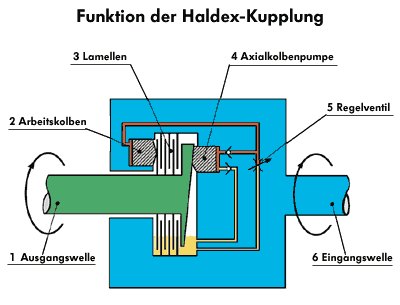I remember 25 years ago, someone discovered viscous couplings and decided to convert a Landcruiser Wagon to full-time 4WD - by inserting a VC in the front tailshaft. I shook my head.
Did he work for Lamborghini by chance because thats how they do it the difference being that unlike the Cruiser'50/50 the Lambo's 30/70 is slipping 100% of the time.
I knew I had seen a wet multiple clutch pack drive before, I just didn't know that a good bulk of the worlds AWD's use them ...
http://en.wikipedia....Haldex_TractionSince the late 1998,
Volkswagen replaced the viscous-coupling Syncro system with a new system called "4motion". First shown in Audi TT and Golf 4motion, the new system uses a multi-plate clutch center differential developed by a Swedish company, Haldex, and computer software from the Austria 4WD specialist Steyr-Daimler-Puch. At this moment, it is only offered for the transverse-engined Golf IV platform, but there is no technical reason prevents it from applying to Audi's longitudinal-engined models.
The Haldex center differential is similar to Porsche 959's PSK system mentioned in the above, it is only smaller, simpler and cheaper thus making mass production feasible. The center differential is mounted near the rear axle and just in front of the rear differential. As shown in the picture below, its clutch consists of 6 discs ....

They are immersed in oil bath to reduce friction. Actuation is made by hydraulic pressure. Normally the input and output shafts rotate with a speed difference (could be implemented by different final drive ratio), therefore the discs are rotating relative to each other. When no pressure is applied, the clutch is not engaged thus torque will not be transferred to the rear axle. Increase the pressure on the multiplate clutch, the latter will be partially engaged, thus sending torque to the rear axle. The more the clutch engages, the more torque transfers to the rear axle.
Computer determines how much torque to be sent to the rear wheels. Normally it is 50:50, but in tight corners when wheels on one of the axles is slipping, the driver can easily feel the torque is transffering from one to another axle. Volkswagen claimed 100% torque could be sent to either axle.
Compare with 959's unit, Haldex's unit has 7 fewer discs in the clutch. This makes the Haldex unit more compact and cheaper. The down side is not capable to handle as much torque (959 had 369 lbft, Audi TT has 206 lbft). Besides, 959's discs were organised as 6 pairs of independent clutches, each actuated by individual hydraulic actuator. The Haldex has just one actuator acting on all six discs, again, this saves weight and cost. However, I suspect if it could vary the amount of torque split as precise as independent clutches.
Based on the journalists comment about the handling of Audi TT and Golf 4motion, it seems that the 4motion system performs even better than the traditional Torsen-differential Quattro. The age of Torsen Quattro is passing away.
Others ....
Porsche 959's PSK uses a multi-plate clutch instead of center differential. You may call it a "differential clutch" as well. The multi-plate clutch has 6 pairs of frictional plate, each pair is independently controlled by computer and actuated by hydraulic pressure. This simply equals to 6 independent clutches.
To make this system work, the front and rear driveshafts must run at different speed in normal condition. (so 959 adopted a pair of front tyres with 1% larger diameter than the rear's) Because of the speed difference between front and rear driveshafts, the 2 frictional plates of each independent clutch are rotating relatively to each other. When apply hydraulic pressure to the first clutch, a small amount of torque will transfer to the front axle. But note that the two driveshafts cannot be fully locked up unless all 6 clutches are locked simultaneously.
Now, you may see how it works: lock up 2 clutches, 3 clutches ... and the torque to front wheels will be increased, subsequently, torque split could be 50:50 if all the clutches are fully engaged. Of course, all these action is controlled by computer.
This is only for "normal" condition. Like other 4WD systems, when tyre slip occurs, most of the torque could be
sent to either axle.
What about energy loss and wear due to the slipping clutches? As the speed difference is very small, Porsche claimed energy loss is no greater than 0.4% of the power developed by the engine. As for wear, the clutch is dimensioned that it was negligible and caused no problem during the whole life span.
Mercedes 4-Matic is very much like Porsche's PSK, but it works as a part-time 4WD. In normal condition, the clutches are disengaged so that the car runs just like any rear-wheel drive version. When it lose traction, the computer will signal the clutches to engage progressively so to transfer some torque to the front wheels.
This is rather irrational. It costs even more than Torsen system, but only offers part-time 4WD. However, unlike Porsche's PSK, it is not subjected to any energy loss or wear during normaly conditions, so the clutch can be made smaller and cheaper.
Since the R33, Nissan's Skyline GT-R also uses multi-plate clutch instead of conventional center differential, in addition, as rear differential lock too. Normally it is rear-wheel drive, the front wheels only intervene whenever necessary.
What makes the Skyline system catches my heart is its real world behaviour. Without driving it or reading road test reports, you might not discover its maturity.
As I have mentioned earlier, throttle-controllable oversteering is usually more desirable to real drivers than pure neutral steering. However, what a pity most permanent four-wheel drive cars are inherently unable to deliver power oversteering. Porsche 959 was one of the exception because it had 60% weight bias towards the rear, but for a front-engined car like the Skyline GT-R, the best solution is to leave it as rear-wheel drive in normal conditions.
The clever electronic control system is fed by all the information that Porsche 959 had, such as G-force, boost pressure, throttle position etc, in addition, the speed of individual wheels measured by ABS wheel speed sensors. By these information, the computer knows whether the car is running out of cornering limit or not. If not yet, the multi-plate clutches won't intervene, thus the car can power slide through the corner smoothly. In case out of limit, the multi-plate clutch will engage and send torque to front wheels, increasing traction.
This makes Skyline a rare example of 4WD having oversteering ability.
Honda's SH-AWD system is unique in the industry. It does not have any center differential or any limited-slip differential. All the mechanicals is mounted at the rear axle. The drive from propeller shaft is sent to an accelerator first. The latter uses planetary gears to step up the rotation speed, creating a speed difference between the input and output shaft. By applying electromagnetic clutches, the speed difference can transfer driving torque to the rear axle.
The electromagnetic multi-plate clutches are mounted behind the accelerator. There are 2 clutches, each responsible for one rear wheel. When the right clutch engage, more torque will be sent to the left rear wheel via the conventional differential. Vice versa, engage the left clutch will transfer more torque to the right rear wheel. (This theory is the same as Mitsubishi's Active Yaw Control) When both clutches engage, more torque will be sent to the rear axle. In this way, SH-AWD can very the torque split between front and rear axle, as well as between the rear wheels.
For Honda Legend equipped with SH-AWD, it normally runs with 70% torque distributed to the front wheels. Under acceleration and braking, up to 70% may be sent to the rear axle to generate more traction. During cornering, to reduce understeer, more torque will be distributed to the outside rear wheel. At extreme cases, the outside rear wheel can take 70% of the engine output, while the inside rear wheel 0% and the front wheels get the remaining 30%. When braking into corners, to correct the tendency of oversteer, more torque will be distributed to the inside rear wheel, taking advantage of the engine braking to reduce oversteer.
The above information courtesy of www.autozine.org, theres more there to...
http://www.autozine....ction_4wd_2.htm
Edited by cheapracer, 05 April 2011 - 09:39.


















